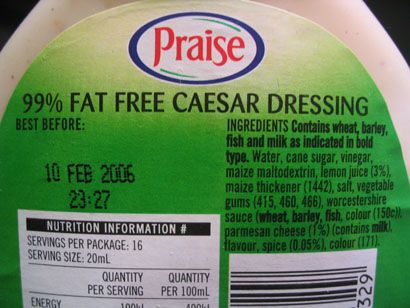Yuck, its "fat free"
I made a salad. The dressing was a “99% Fat Free Caesar Dressing” that came straight out of the fridge. In my defence, the normal dressing was not available, hence settling for the fat free alternative.
When cold, this particular fat free dressing became a viscous, gooey gel quite unlike salad dressings that are served to human beings. Look, that blob of dressing even holds a pointed tip. Gross stuff…

Ideally, dressings should be inviscid* and have low surface tension. These characteristics would allow the dressing liquid to spread and smear over the many vegetable surfaces present in the salad.
Normal dressings behave perfectly fine at high AND low temperatures. This fat-free stuff is not looking very promising; when cold, it looks like jelly, or hair gel, or a perverted blend of mayonnaise and semen. If I want jelly I can very well get my own jelly.

Here’s the ingredients list transcribed from the label.
INGREDIENTS Contains wheat, barley, fish and milk as indicated in bold type. Water, cane sugar, vinegar, maize maltodextrin, lemon juice (3%), maize thickener (1442), salt, vegetable gums (415, 460, 466), worchestershire sauce (wheat, barley, fish, colour (150c)), parmesan cheese (1%) (contains milk), flavour, spice(0.05%), colour(171).

It turns out that mayonnaise is used in great quantities when making Caesar dressing. So this is what fat-free does- replacing mayonnaise with carbohydrates and gums.
Maltodextrin:
Maize thickener 1442 (hydroxy propyl distarch phosphate):
Vegetable gum 415 (xanthan gum):
*inviscid- having no or negligible viscosity
Sources:
Sarah Anderson, "A Rough Guide to E-Numbers", University of Bristol.
"Maltodextrin", Everything2
"Maltodextrin", Wikipedia
Mauro & Wang (2001), "The Breakfast of Champions", "Food Product Design"
Martin Chaplin(2005), "Xanthan Gum", "Water Structure and Behavior", London South Bank University
When cold, this particular fat free dressing became a viscous, gooey gel quite unlike salad dressings that are served to human beings. Look, that blob of dressing even holds a pointed tip. Gross stuff…

Ideally, dressings should be inviscid* and have low surface tension. These characteristics would allow the dressing liquid to spread and smear over the many vegetable surfaces present in the salad.
Normal dressings behave perfectly fine at high AND low temperatures. This fat-free stuff is not looking very promising; when cold, it looks like jelly, or hair gel, or a perverted blend of mayonnaise and semen. If I want jelly I can very well get my own jelly.

Here’s the ingredients list transcribed from the label.
INGREDIENTS Contains wheat, barley, fish and milk as indicated in bold type. Water, cane sugar, vinegar, maize maltodextrin, lemon juice (3%), maize thickener (1442), salt, vegetable gums (415, 460, 466), worchestershire sauce (wheat, barley, fish, colour (150c)), parmesan cheese (1%) (contains milk), flavour, spice(0.05%), colour(171).

It turns out that mayonnaise is used in great quantities when making Caesar dressing. So this is what fat-free does- replacing mayonnaise with carbohydrates and gums.
Maltodextrin:
Maltodextrin is a moderately sweet polysaccharide used as a food additive, unrelated to barley malt. It is produced from corn starch and is usually found as a creamy white hygroscopic powder. Maltodextrin is easily digestible, being absorbed as rapidly as glucose.
Maltodextrin is a very simple and flavorless carbohydrate. It is rapidly absorbed by the body and contributes to rapid uptake by muscle tissues of key nutrients that have been depleted by exercise. In this role it has an anabolic effect in rapidly refilling glycogen reserves.
Current products use either maltodextrin or corn-syrup solids as fat replacers. Both maltodextrin and corn-syrup solids are hydrolyzed starch. Maltodextrin and corn-syrup solids impart a smooth texture that mimics the mouthfeel and structural attributes of fat crystals.
Maize thickener 1442 (hydroxy propyl distarch phosphate):
Thickener and stabiliser
Thickener: Thickeners produce viscous solutions or dispersions and are used to impart body, improve consistency, or stabilise emulsions. They include suspending and bodying agents, setting agents, gel builders, bulking agents, etc.
Stabiliser: Stabilisers produce viscous solutions or dispersions and are used to impart body, improve consistency, or stabilise emulsions. They include suspending and bodying agents, setting agents, gel builders, bulking agents, etc.
Vegetable gum 415 (xanthan gum):
Xanthan gum is mainly considered to be non-gelling and used for the control of viscosity due to the tenuous associations endowing it with weak-gel shear-thinning properties. It hydrates rapidly in cold water without lumping to give a reliable viscosity, encouraging its use as thickener, stabilizer, emulsifier and foaming agent.
*inviscid- having no or negligible viscosity
Sources:
Sarah Anderson, "A Rough Guide to E-Numbers", University of Bristol.
"Maltodextrin", Everything2
"Maltodextrin", Wikipedia
Mauro & Wang (2001), "The Breakfast of Champions", "Food Product Design"
Martin Chaplin(2005), "Xanthan Gum", "Water Structure and Behavior", London South Bank University

<< Home